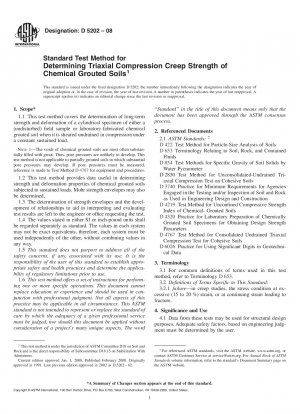ASTM D5202-08
Standard Test Method for Determining Triaxial Compression Creep Strength of Chemical Grouted Soils
- Standard No.
- ASTM D5202-08
- Release Date
- 2008
- Published By
- American Society for Testing and Materials (ASTM)
- Status
- Replace By
- ASTM D5202/D5202M-16
- Latest
- ASTM D5202/D5202M-16
- Scope
Data from these tests may be used for structural design purposes. Adequate safety factors, based on engineering judgment must be determined by the user.
Note 28212;Sampling procedures for in-situ specimens have a major influence on test results. Specimens carefully trimmed in the laboratory from large block samples taken in the field have the least chance of fracturing prior to testing. Sample preparation methods of laboratory-fabricated specimens also have a major influence on test results. Specimens should be fabricated in accordance with Test Method D 4320
. Note 38212;The quality of the result produced by this test method is dependent on the competence of the personnel performing it, and the suitability of the equipment and facilities used. Agencies that meet the criteria of Practice D 3740
are generally considered capable of competent and objective testing/sampling/inspection/etc. Users of this test method are cautioned that compliance with Practice D 3740 does not in itself assure reliable results. Reliable results depend on many factors; Practice D 3740 provides a means of evaluating some of those factors. 1.1 This test method covers the determination of long-term strength and deformation of a cylindrical specimen of either a (undisturbed) field sample or laboratory-fabricated chemical grouted soil when it is sheared undrained in compression under a constant sustained load.
Note 18212;The voids of chemical grouted soils are most often substantially filled with grout. Thus, pore pressures are unlikely to develop. This test method is not applicable to partially grouted soils in which substantial pore pressures may develop. If pore pressures must be measured, reference is made to Test Method D 4767
for equipment and procedures. 1.2 This test method provides data useful in determining strength and deformation properties of chemical grouted soils subjected to sustained loads. Mohr strength envelopes may also be determined.
1.3 The determination of strength envelopes and the development of relationships to aid in interpreting and evaluating test results are left to the engineer or office requesting the test.
1.4 The values stated in either SI or inch-pound units shall be regarded separately as standard. The values in each system may not be exact equivalents, therefore, each system must be used independently of the other, without combining values in any way.
1.5 This standard does not purport to address all of the safety concerns, if any, associated with its use. It is the responsibility of the user of this standard to establish appropriate safety and health practices and determine the applicability of regulatory limitations prior to use.
1.6 This test method offers a set of instructions for performing one or more specific operations. This document cannot replace education or experience and should be used in conjunction with professional judgment. Not all aspects of this practice may be applicable in all circumstances. This ASTM standard is not intended to represent or replace the standard of care by which the adequacy of a given professional service must be judged, nor should this document be applied without consideration of a project''s many unique aspects. The word “Standard” in the title of this document means only that the document has been approved through the ASTM consensus process.
ASTM D5202-08 Referenced Document
- ASTM D2850 Standard Test Method for Unconsolidated-Undrained Triaxial CompressionTest on Cohesive Soils
- ASTM D3740 Standard Practice for Minimum Requirements for Agencies Engaged in the Testing and/or Inspection of Soil and Rock as Used in Engineering Design and Construction
- ASTM D4219 Standard Test Method for Unconfined Compressive Strength Index of Chemical-Grouted Soils
- ASTM D422 Standard Test Method for Particle-Size Analysis of Soils
- ASTM D4320 Standard Test Method for Laboratory Preparation of Chemically Grouted Soil Specimens for Obtaining Design Strength Parameters
- ASTM D4767 Standard Test Method for Consolidated Undrained Triaxial Compression Test for Cohesive Soils
- ASTM D6026 Standard Practice for Using Significant Digits in Geotechnical Data
- ASTM D653 Standard Terminology Relating to Soil, Rock, and Contained Fluids
- ASTM D854 Standard Test Methods for Specific Gravity of Soil Solids by the Water Displacement Method
ASTM D5202-08 history
- 2016 ASTM D5202/D5202M-16 Standard Test Method for Determining Triaxial Compression Creep Strength of Chemically Grouted Soils
- 2008 ASTM D5202-08 Standard Test Method for Determining Triaxial Compression Creep Strength of Chemical Grouted Soils
- 2002 ASTM D5202-02 Standard Test Method for Determining Triaxial Compression Creep Strength of Chemical Grouted Soils
- 1997 ASTM D5202-91(1997) Standard Test Method for Determining Triaxial Compression Creep Strength of Chemical Grouted Soils
